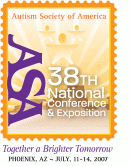 |
The ASA's 38th National Conference on Autism Spectrum Disorders (July 11-14, 2007) of ASAThe Westin Kierland Resort & Spa, Scottsdale, AZ |
| For a complete author index with session numbers, please click here | |
| Saturday, July 14, 2007: 8:15 AM-9:30 AM | |||
| Rainmakers Ballroom A | |||
| #2866- A Team Approach to Teaching Language: Behaviorists and Speech Pathologist Working Together- BCBA Session* | |||
| Applied Behavior Analysis is well-researched as an effective treatment for children with autism. Speech & Language therapy is a primary method of treatment. Both modalities have documented success teaching children with autism, yet rarely have the two approaches co-mingled to streamline treatment decisions. Review the development of a Decision-making Treatment Tree coordinated by a Speech and Language Pathologist and a Board Certified Behavior Analyst to determine language curriculum and enhance speech & language development in treatment to children with autism. | |||
| Presenters: | - Kelly McKinnon is a Board Certified Behavior Analyst in private practice in Southern California. She has written a book: Social Skills Solutions, a hands-on guide for teaching social skills to children with autism. She runs a comprehensive clinic in San Juan Capistrano that includes Speech & Language therapy, Social Skills classes, Occupational Therapy and parent training. She is a regular contributor to Autism News of Orange County & the Rest of the World and speaks regularly on the topics of addressing social skill and curriculum in the treatment of children with autism, including 2006 CALABA workshops.
- Shaun Howell has been a practicing speech pathologist for over 10 years, and specializes in facilitating language skills in children with autism. In addition, she has expertise in the areas of oral motor development, dyspraxia, articulation and dysphagia. She conducts individuals as well as group treatment sessions in her clinic in Southern California. | ||
|
| |||
|
In this workshop, participants will understand language development from a speech & language perspective, as well as a from a behaviorist perspective for children with autism, and see how these approaches can be combined for effective treatment. The use of a decision making tree is used for collaboration as well as designing, modifying and streamlining treatment plans A decision making tree is a model comprised of yes and no questions that clinicians would ask himself/ herself related to challenges and needs the child with autism presents. Along with the review of the decision making tree, several case studies will be presented, demonstrating how decisions can and will be made for collaboration and treatment. One case study will show an example of an initially non-verbal child. Using this decision making tree, the question can be asked a question, “is the child apraxic?” If the answer is yes, the behaviorist would strongly rely on recommendations and treatment planning from the speech pathologist. If the child is not apraxic, both professionals may ask themselves what behaviors are preventing speech/ communication skills from acquiring. In this case, the speech pathologists would strongly rely on support from the behaviorist for the appropriate treatment plan. The model is used on an ongoing basis throughout the course of treatment. Participants will see a decision making tree that was formulated by a behaviorist and speech path. Both clinicians felt that although they each had over 10 years experience treating children, using a collaborative model increased the rate and quality of progress for the children they have recently collaborated with. |
|||
See more of General Submissions
See more of The ASA's 38th National Conference on Autism Spectrum Disorders (July 11-14, 2007)